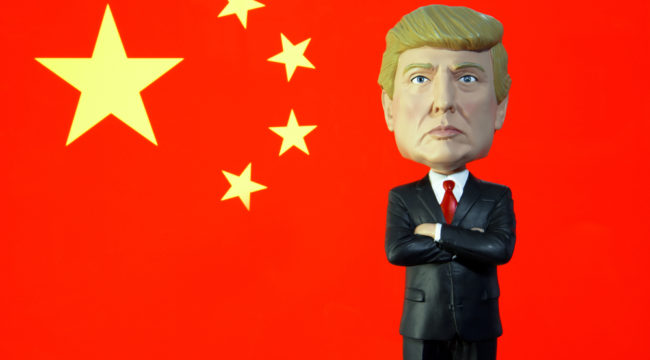How Trade War Can Actually Boost the Stock Market
Round and round it goes, and where it stops, nobody knows…
China announced plans yesterday to impose 25% tariffs on an additional $16 billion worth of U.S. products.
The imposts enter effect on Aug. 23 — the precise date when the United States imposes its own 25% tariffs on $16 billion in Chinese goods.
The Chinese government claims it was “forced to retaliate.”
And at a perfect one for one, Chinese retaliation is nothing if not measured.
But where does it end?
Wars are easy to start… but not always easy to stop.
And if the U.S. tariffs were designed to lower the trade deficit with China, the business has not yet matched its advertising.
The trade deficit scaled a record high in June — nearly $29 billion.
At $28.1 billion, July’s trade deficit ran a close second.
With bated breath we await August’s data.
Stocks were mostly lower today on the news.
The Dow Jones closed the day 45 points in red territory.
The S&P was flat, while the Nasdaq scratched out a slender five-point gain.
But could trade war fears actually propel markets higher?
A scandalous question, to be certain.
Are not these fears at least partly responsible for this year’s roller-coasting stock market?
After all, tariffs generally raise the costs of business inputs.
These costs ripple throughout the economy… like a splashing stone sends ripples across a still lake surface.
Businesses pull in their oars… lower their sights… cancel projects and reduce investment in their growth.
We note that a survey by the National Association for Business Economics reveals 76% of economists believe current trade policies will drag on the economy.
But because of this year’s tax cuts, corporate coffers burst with cash.
If trade wars keep it out of productive use… what to do with the overflow?
The answer, for many, is obvious:
Buy your own stock.
Explains Reuters:
The escalating trade war between the United States and China may prompt U.S. companies to shift money they had earmarked for capital expenditures into stock buybacks instead, pushing record levels of corporate share repurchases even higher.
Our own Nomi Prins, in affirmation:
In a world of uncertainty, cash is king. With the $34 billion worth of tariffs on goods from the U.S. and China, and the possibility of Trump slapping another $200 billion of tariffs on Chinese goods, companies are running scared.
That kind of incentive is a strong catalyst for banks to deploy a chunk of their tax cut savings into buying their own stocks.
Second-quarter buybacks are up 57% over last year’s.
Goldman Sachs now projects that stock repurchases will total $1 trillion this year — 46% higher than last year.
And as we explained last week, Apple’s record buybacks are partly responsible for it becoming the first U.S. corporation to a $1 trillion market cap.
What a corporation does with its money is none of our business — or anyone else’s but its shareholders.
Whether it spends its bounty on buybacks, thumbtacks, or bootblacks… it is all one to us.
But an unwholesomeness hangs about the entire business…
Were you aware that stock buybacks were illegal for much of the 20th century?
The old regulators, with their straight faces, straight rulers and straight laces, considered them a form of stock market manipulation.
And are they not — in a sense?
The higher stock prices they produce do not result from constructing a superior mousetrap. Or inventing an improved wheel.
They result instead from the toolkit of the financial engineer.
But the old ways soften… the wooden rulers acquire a bend with age… and the straight laces eventually come undone.
In 1982 the SEC essentially legalized buybacks — under a pulverizing rain of Wall Street lobbyists, we imagine.
Now, over 30 years later, stock buybacks have helped push stocks to record heights… and scarcely anyone gives it a second thought.
Here is progress — of a sort.
Regards,
Brian Maher
Managing editor, The Daily Reckoning



Comments: